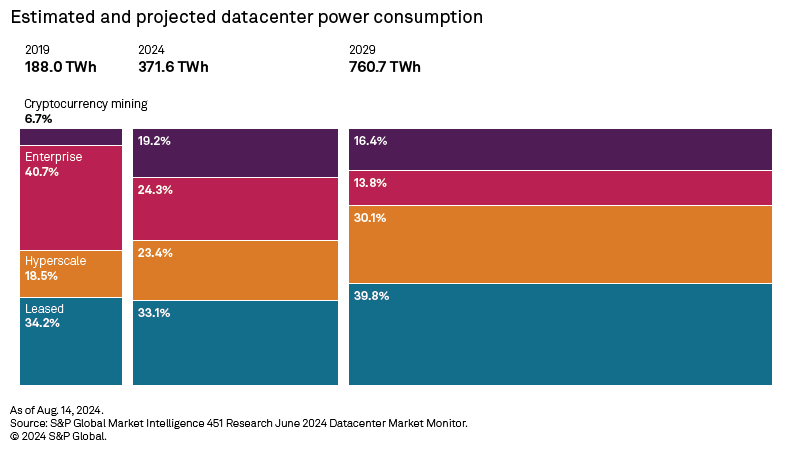US datacenter energy demand forecasts are rising exponentially on the back of the sector's seemingly relentless expansion, with 451 Research now anticipating 681 TWh annually in 2028 — a more than 28% upward adjustment in less than three months. Meanwhile, datacenter owners remain publicly committed to greening their electricity supply and redoubling their power purchase agreement activity. Juxtaposing the space's 24/7 power needs with solar and wind intermittency, however, increasingly raises reliability concerns.
Concurrent developments are behind the spike in datacenter power demand. The sheer volume of new server-housing facilities breaking ground — overall US net operational datacenter space now projected to grow over 58% in the next five years to more than 480 million square feet — is magnified by the industry's increasing adoption of the graphic processing units (GPUs) AI requires, with GPUs necessitating as much as 10 times more energy per chip than traditional CPUs.

Renewable energy is intermittent, though this sporadicity varies across sources. Solar projects will run only in the daytime, but air currents may spin a wind turbine anytime. Be that as it may, peak renewable generation and power demand are not always in sync, resulting in periods of excess generation — which may compel grid managers to curtail valuable output that could have been produced — and vice versa. Battery energy storage systems (BESSs) are key to ultimately bridging this gap and BESS capacity is being deployed at breakneck speed to do just that. In the meantime, natural gas generation is expected to continue playing a sizable role in meeting the rising overall energy demand anticipated in the next decade, notably in Texas — one of the top datacenter hubs in the US.

➤ The technology and services sector accounts for just over half the renewable energy capacity contracted by corporate offtakers in the US, with hyperscalers, such as Amazon.com Inc., Alphabet Inc. (Google), Microsoft Corp. and Meta Platforms Inc., accounting for over 95% of that capacity.
➤ Wind and solar combined now account for 20.9% of the installed generating capacity in the US, but generation lags, accounting for an estimated 14.7% of generation in MWhs, underscoring the intermittency of renewables.
➤ This intermittency is best captured by capacity factor, which is the ratio of a power plant's actual output to its output if it ran uninterrupted. US average annual capacity factors for solar and wind come in at 24% and 38%, respectively, but these metrics vary by location and time of year.
➤ Intermittent and non-dispatchable technologies, such as wind and solar, are subject to grid maintenance measures, including curtailment — when operators purposefully reduce a power plant's output during times of excess generation.
➤ Despite widespread implementation of renewable generation and decarbonization targets, natural gas is expected to remain a formidable part of the US energy mix in the foreseeable future. This is perhaps most evident in Electric Reliability Council of Texas Inc., where natural gas' generation share is forecast to slowly increase over the next decade despite being an ongoing US hub for utility-scale renewable development.


Datacenter companies hoping to maintain pace with the rapid expansion of both cloud computing and AI capabilities are realizing the associated spike in energy demand is upending progress towards self-imposed clean energy commitments. Nascent technologies such as small modular nuclear reactors, long-duration battery storage and green hydrogen are yet to become commercially viable; intermittent wind and solar generation, therefore, remain the carbon-free technologies of choice, with dispatchable fossil fuel generation such as natural gas forced to fill the gaps.
Data visualization by Chrisallen Villanueva.
For wholesale prices and supply and demand projections, see the S&P Global Market Intelligence Power Forecast.
Regulatory Research Associates is a group within S&P Global Commodity Insights; 451 Research is part of S&P Global Market Intelligence. S&P Global Commodity Insights and S&P Global Market Intelligence are divisions of S&P Global Inc.
S&P Global Commodity Insights produces content for distribution on S&P Capital IQ Pro.
This article was published by S&P Global Market Intelligence and not by S&P Global Ratings, which is a separately managed division of S&P Global.



